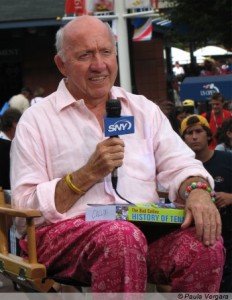 Bud Collins, the world’s most famous tennis historian and journalist, reviews the history of the Australian Open in this exclusive excerpt from his famed book THE BUD COLLINS HISTORY OF TENNIS ($35.95, New Chapter Press, www.NewChapterMedia.com)
Bud Collins, the world’s most famous tennis historian and journalist, reviews the history of the Australian Open in this exclusive excerpt from his famed book THE BUD COLLINS HISTORY OF TENNIS ($35.95, New Chapter Press, www.NewChapterMedia.com)
*****
Tennis had been played Down Under for 25 years before a national championship was organized in 1905 in Melbourne at the Warehousemen’s Ground—this four years after six British Colonies had come together as the Commonwealth of Australia. It was men only at first, as was the case with the U.S. and Wimbledon championships. The tournament was called the Australasian Championships, a cooperative venture with neighboring New Zealand, a country that also shared a Davis Cup team with the Aussies, notably in the person of Kiwi Tony Wilding. Wilding and Aussie Norman Brookes won four Cups for Australasia: 1907-08-09, 14. New Zealand dropped from the alliance after 1922, and in 1927, this event became the Australian Championships.
Strikingly, the first champ in 1905, and 64 years later the first champ of the “Open” era were Rodneys: Rodney Heath, the initial victor over Arthur Curtis, 4-6, 6-3, 6-4, 6-4 in a field of 17; Rodney Laver, 6-3, 6-4, 7-5, over Spaniard Andres Gimeno in a field of 48 at Brisbane in 1969. In 1908, American Fred Alexander was the first foreigner to win the singles and doubles titles–3-6, 3-6, 6-0, 6-2, 6-3 over homeboy Alf Dunlop then joined Dunlop to complete a personal sweep.
Not until 1922 did women enter the picture when 27-year-old Mall Molesworth beat 20-year-old Esna Boyd, 6-3, 10-8, in the final in Sydney. They played alongside the men, except for three separate tournaments, 1980–82. Dorothy Round, in 1935 at Melbourne, was the first female outsider as champion, beating Nancy Lyle in an all-English final, 1-6, 6-1, 6-3. Dorothy Bundy (now a Hall of Famer as Mrs. “Dodo” Cheney), was the first American woman to win, defeating Dorothy Stevenson, 6-3, 6-2, in 1938 at Adelaide. That year, another Yank, Don Budge, launched the original Grand Slam with a 6-4, 6-2, 6-1, victory over John Bromwich. The courts for the tournament were grass until 1988. Then, a rubberized hard court surface called Rebound Ace complemented the new national tennis complex called Flinders Park (the name changed to Melbourne Park in 1998). Because that pavement became sticky on very hot summer days, it was replaced in 2008 by hard courts called plexicushion, colored blue rather than the customary green.
Though Melbourne has been the site of the tournament since 1972, it moved about often in earlier days among five Australian cities: Brisbane (1907, 15, 23, 56, 60, 64, 69); Sydney (1908, 19, 22, 25, 28, 31, 34, 37, 40, 47, 51, 54, 58, 62, 66, 70-71); Perth (1909, 13, 21); Adelaide (1910, 20, 26, 29, 32, 36, 38, 46, 49, 52, 55, 59, 63, 67); Melbourne (1911, 14, 24, 27, 30, 33, 35, 39, 48, 50, 53, 57, 61, 65, 68); and two in New Zealand: Christchurch (1906); Hastings (1912). Melbourne was the most successful host after the Kooyong Lawn Tennis Club erected a 12,000 seat concrete horseshoe in 1927. Stadia at White City, Sydney (1922), Memorial Drive, Adelaide (1920), and Milton Courts, Brisbane, were other prominent locations.
Australia, lagging behind the other three majors in prestige, interest, prize money and player fields, needed a lift and got a tremendous one in 1988 with the christening of the attractive new playpen, Flinders/Melbourne Park. Modernity took over. Suddenly the Australian was the style-setter with a retractable roof for the principal stadium (named Rod Laver Arena in 1992), seating 14,820. In 2000, another such arena was added seating 11,000 and also with a retractable roof. The Aussies were ahead of the game with no bothersome rain-outs, nor TV networks stalled with nothing live to show. Strangely (obtusely?), Wimbledon and the U.S. weren’t respective copycats when the new Court 1 and Ashe Stadium were opened, respectively, in 1997.
Abandoned, as a big-time stop on the tour as Forest Hills had been in 1978, famed Kooyong (using temporary stands to pack in 17,500 for the 1953 Davis Cup final) settled into a comfortable private club existence. An attendance record (140,000) was set for Kooyong’s farewell to the Open, 1987. That was quickly surpassed at Melbourne Park. In 2008, the event drew a record 605,735 fans.
Two championships were held in 1977 when the tournament moved from January to December dates, and no event was held in 1986 to readjust to the traditional January date. The tie-breaker was adopted in 1971, not in force for ultimate sets, the fifth for men, third for women.
Showing some reluctance in joining the “Open” era, the Australian was the last of the three majors to take the plunge, remaining amateur in 1968, then integrating with $25,000 in prize money the following year. That figure accelerated to $18,813,400 in 2008, prize money equally paid the women since 2001. Laver got $5,000 as the 1969 champ, Margaret Smith Court $1,500, a pittance compared with $1,217,930 in 2008 with singles winners Novak Djokovic and Maria Sharapova winning just shy of $1.2 million. The event’s championship cups honor the memory of two bygone champs, both Australian, Daphne Akhurst for the women and Norman Brookes for the men. Alas for the citizenry, no homebody has clung to that silver since Chris O’Neil in 1978 and Mark Edmondson in 1976.
